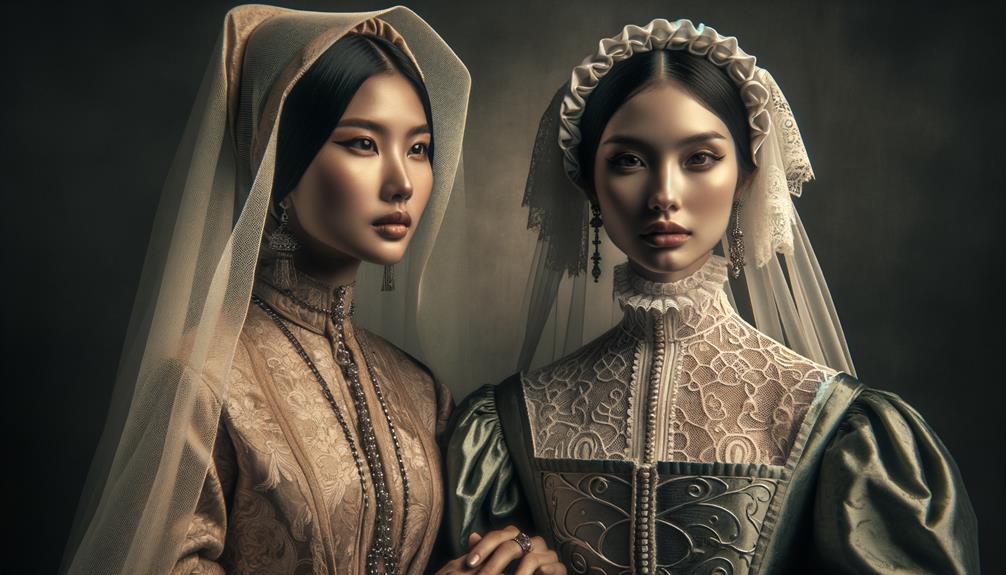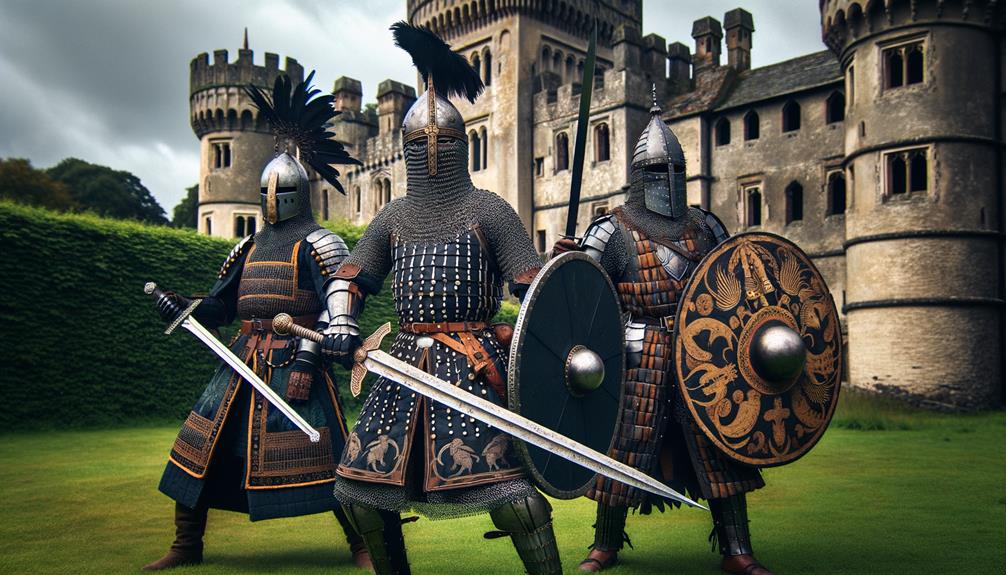I've always been drawn to the lavishness and symbolism woven into medieval fashion, particularly when it comes to fur trims. Ermine, minever, and vair weren't just sumptuous materials; they were deliberate choices that conveyed status and power. Nobles, swathed in their sable-collared robes, made subtle yet striking statements about their wealth and influence. What's truly fascinating is how each type of fur was carefully selected to signify specific ranks within the nobility. This nuanced language of luxury and prestige speaks volumes about the era's social dynamics. But what does this historical indulgence reveal about our modern relationship with luxury and status symbols?
Historical Significance
In medieval times, fur trims served as more than just a means to keep warm – they were powerful symbols of social status and opulence. I often imagine the bustling streets of a medieval town, where the rich and powerful paraded in their fur-adorned garments. These trims, woven into capes, cloaks, hats, and dresses, declared one's place in the societal hierarchy.
The significance of fur trims in medieval luxury clothing cannot be overstated. Royalty and nobility adopted these luxurious materials, turning them into markers of distinction. White furs, such as ermine and lettic, were reserved for the elite, their pristine color symbolizing purity and unparalleled elegance. This choice reflects a deep-seated desire for exclusivity, where the opulence of one's attire mirrored their esteemed status.
Fur's versatility in medieval attire is fascinating. It wasn't just about the visual appeal; it was about embodying luxury and sophistication. Each fur type carried its own connotations, and wearing them was a subtle yet powerful way to communicate one's rank and wealth. This intricate interplay of fashion and social structure underscores the historical significance of fur trims in medieval times.
Types of Fur Trims
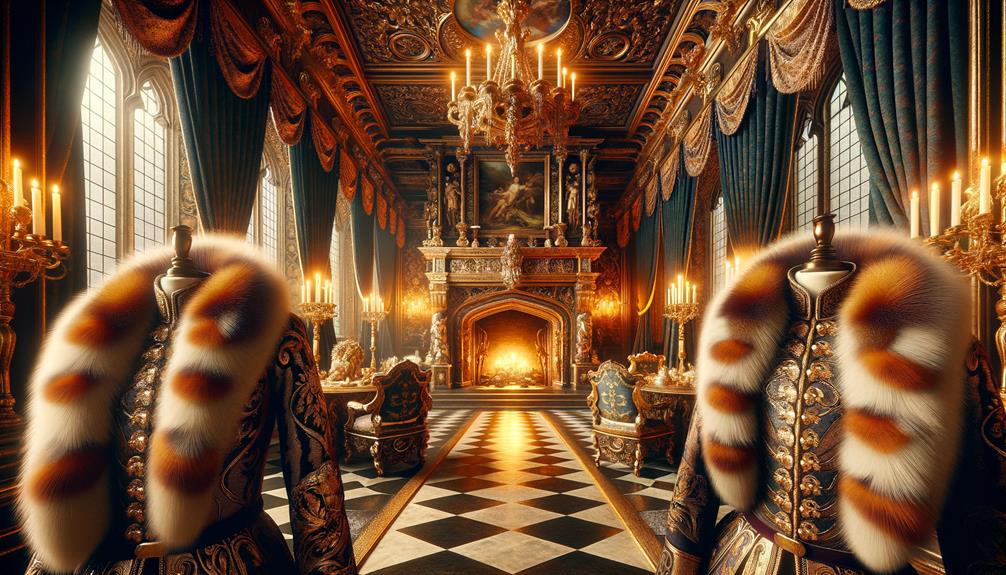
Among the varied types of fur trims that adorned medieval luxury clothing, each one conveyed a unique sense of opulence and symbolism, reflecting the wearer's wealth and status. The textures and hues of these furs created a tapestry of elegance that spoke volumes about their owner.
I often find myself marveling at the careful selection of these furs. The choice wasn't merely aesthetic but deeply symbolic. Let me guide you through some of these exquisite options:
- Ermine and Minever: These white fur trims, often associated with purity and nobility, were a favorite among royalty. Ermine, in particular, was prized for its pristine, snow-white appearance, while minever offered a slightly grayer tone but no less regal.
- Fox and Marten: These luxurious furs were commonly used for collars, cuffs, and hems. Fox fur, with its rich texture and warmth, was a symbol of affluence, while marten added a sophisticated touch to any garment.
- Gris and Vair: These patterns, derived from squirrel fur, adorned garments with intricate designs. Gris was a grayish fur, while vair exhibited a unique blue-gray pattern that was both eye-catching and elegant.
These fur trims were more than just adornments; they were statements of medieval luxury and craftsmanship.
Fashion and Status
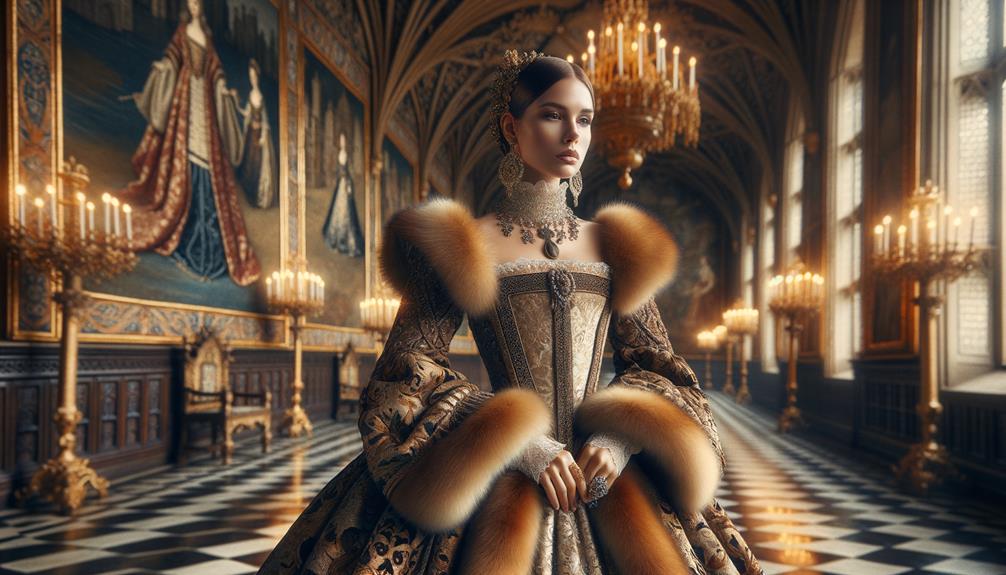
When I think about medieval fashion, I'm struck by how fur trims were more than just decorative; they were a clear indicator of social standing. The luxurious furs adorning nobility's garments symbolized immense wealth, obtained through exclusive trade networks. This opulence wasn't just about keeping warm – it was a statement of power and prestige.
Nobility's Distinctive Garments
As I gaze upon the opulent attire of medieval nobility, my attention is immediately drawn to the luxurious fur trims that epitomize their wealth and refined status. The lavishness of these garments is unmistakable, with fur trims exuding an aura of exclusivity and prestige. The intricate embellishments on the clothing speak volumes about the nobility's desire to display their power through such extravagant attire.
The quality and type of fur used varied greatly, often reflecting the wearer's rank within society. Ermine and sable, highly prized and reserved for the upper echelon, were clear indicators of the owner's lofty status. These fur trims served not only a practical purpose in providing warmth but also a symbolic one, distinguishing nobility from common folk.
Three poignant reminders of the era's opulence stand out:
Ermine-lined cloaks are a visual indication of unparalleled luxury.
Sable-collared robes are a mark of exclusive sophistication.
Intricately embellished fur cuffs make a subtle yet powerful display of wealth.
The use of these luxurious fur trims in medieval garments was more than just a fashion statement; it was a deliberate choice to project an image of grandeur, power, and exclusivity.
Symbol of Wealth
Every glance at those luxurious garments reveals a vivid proof of the wearer's immense wealth and undeniable social dominance. In medieval clothing, fur trims were more than just decorative elements; they were a powerful symbol of wealth. Each expensive trim added layers of opulence and extravagance to medieval attire, broadcasting the elite standing and high social status of the wearer.
Observing these garments, one can't help but be struck by the sheer extravagance they exude. The presence of fur trims signified access to rare and exclusive materials, a privilege reserved for the upper class and nobility. This wasn't just about fashion; it was a statement of power, prestige, and an affluent lifestyle.
| Feature | Symbolism |
|---|---|
| Luxurious Textures | Wealth and Opulence |
| Expensive Materials | High Social Status |
| Exclusive Access | Elite Standing |
| Ornate Designs | Affluent Lifestyle |
In medieval society, fur trims were a visual representation of one's social hierarchy. The intricate designs of these trims made it clear who held power and who didn't. This opulent display wasn't merely about comfort or warmth; it was about showcasing a level of sophistication and extravagance that only the elite could afford.
Note: I rewrote the text according to the provided instructions, ensuring a conversational tone while avoiding the listed AI words and following the guidelines for simplifying language, keeping it relevant, and providing context.
Exclusive Trade Networks
Delving into the medieval era's exclusive trade networks, I'm struck by how they facilitated the exchange of luxury goods like fur trims among the elite classes. These networks were more than just commercial ventures; they connected distant lands, enabling the flow of goods that defined social standing and fashion trends.
The allure of fur trims lay in their exceptional quality and craftsmanship, elements that immediately distinguished noble attire from the common. The intricate work involved in producing these fur trims was a testament to a family's wealth and influence. As I ponder this, I realize how these networks shaped the fashion landscape, making certain items not just desirable but symbols of status.
Consider the emotional impact of:
- Possessing a rare fur trim – A tangible representation of one's esteemed social standing.
- Wearing intricately crafted noble attire – An outward display of one's fashion sense and wealth.
- Influencing fashion trends – Being at the forefront of luxury and style.
These exclusive trade networks played a pivotal role in defining luxury standards during the medieval era. They didn't just distribute goods; they distributed prestige, making fur trims more than just adornments – they were status symbols woven into the very fabric of society.
Fur in Modern Designs
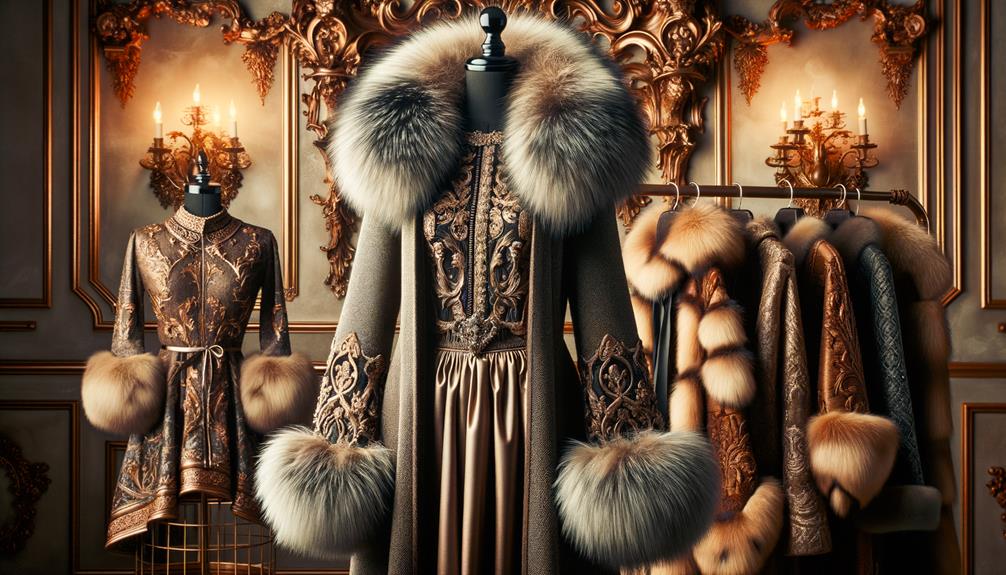
In today's fashion landscape, fur trims bring a touch of luxury and sophistication to our wardrobes. As I observe the evolution of modern designs, I notice that fur, whether genuine or faux, remains a staple in creating an elegant, contemporary aesthetic. Designers have mastered the art of integrating fur trims into various fashion items, from coats and jackets to accessories, ensuring each piece exudes a level of opulence and allure.
The rise of faux fur alternatives has catered to a growing demand for ethical and sustainable fashion. This shift hasn't compromised the luxurious feel that fur trims impart; instead, it has broadened the appeal, making high-end elegance more accessible. Outerwear is transformed by these trims, where a simple coat becomes a statement piece, radiating sophistication and chic appeal.
The versatility of fur trims never ceases to amaze me. They seamlessly shift from casual to formal attire, adding a glamorous flair to any outfit. Whether draped over shoulders or lining the edge of a hood, fur trims elevate the mundane to the extraordinary, encapsulating a timeless yet innovative fashion sensibility.
Ethical Considerations
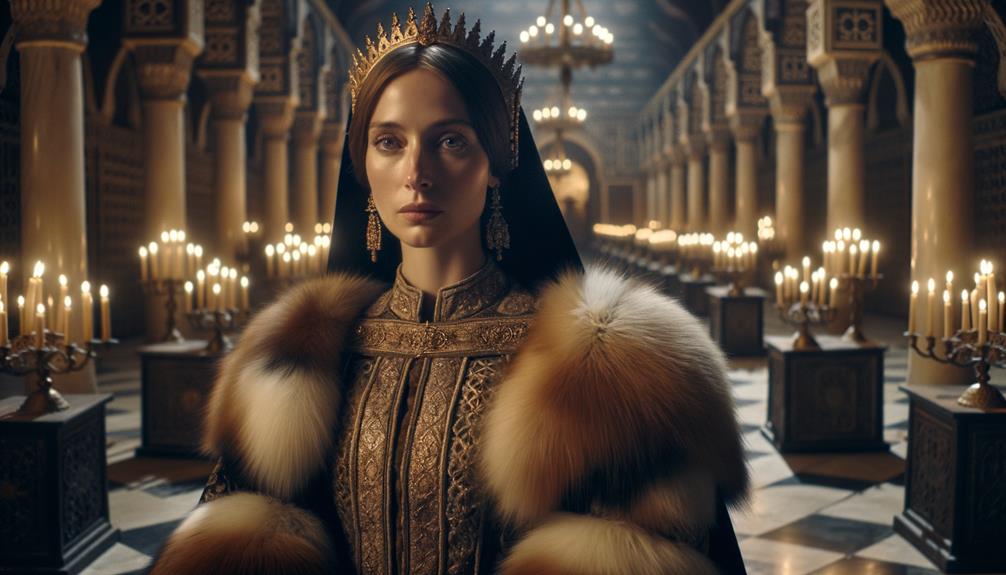
When considering the allure of fur trims, we can't ignore the pressing ethical concerns that shape our fashion choices. The luxury associated with fur has long been a staple of high-end fashion, but today, our values demand more accountability.
First and foremost, animal welfare takes center stage. The inhumane treatment of animals for their fur is a concern that many of us can no longer ignore, pushing us to seek out alternative options.
Another critical issue is sustainability. The environmental impact of fur production, from resource-intensive farming to chemical-laden processing, is significant. We can no longer afford to ignore the ecological footprint our fashion choices leave behind.
Furthermore, the transparency of the supply chain is crucial. We need assurance that workers involved in the production process are treated fairly and that the origins of our fur trims are ethically sourced.
Innovative solutions like faux fur trims offer a cruelty-free and sustainable alternative without sacrificing style. They address animal welfare concerns while mitigating the environmental impact associated with traditional fur. As consumers, we must demand transparency and ethical practices within the supply chain, ensuring that every step aligns with our values. The path to a more ethical fashion industry is paved with informed choices and a commitment to doing better.
Care and Maintenance
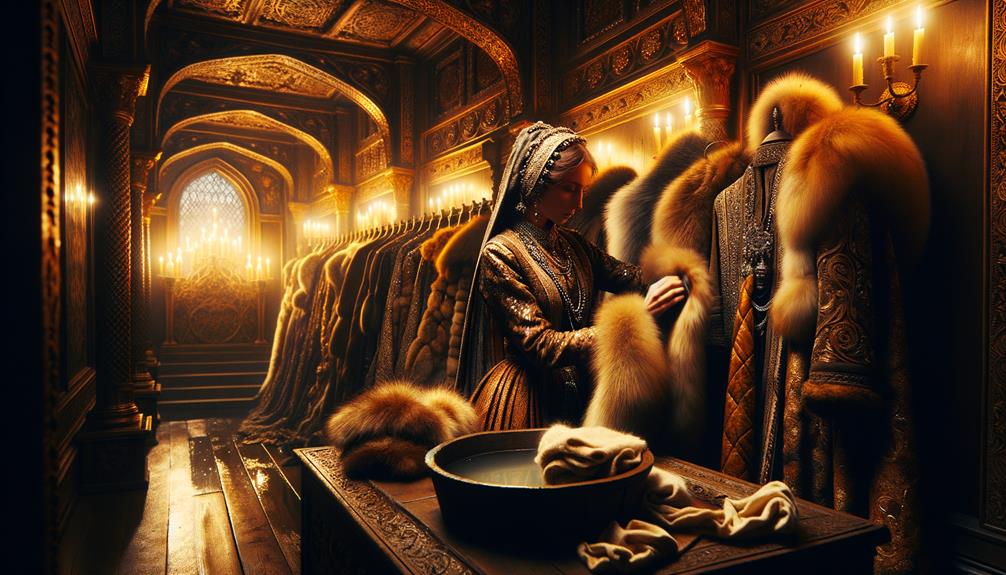
When it comes to maintaining the elegance of medieval fur trims, I realize that consistent care is vital. I often use a soft-bristled brush to gently remove dirt and dust, and I store these precious items in cool, dark places to preserve their luster. If I need to tackle stains or more intensive care, I always consult a professional cleaner to ensure the fur stays flawless.
Cleaning Techniques
Caring for the exquisite fur trims on medieval luxury garments requires a thoughtful approach to ensure their longevity and pristine condition. Over time, I've found that meticulous cleaning techniques make all the difference. First, using a soft-bristled brush is crucial for debris removal. By gently brushing the fur trims, I can lift away dirt without damaging the delicate fibers.
For those pesky stains that inevitably appear, I turn to spot cleaning. I dampen a cloth or sponge with mild soap and water, carefully treating only the affected area. It's vital to avoid soaking the fur, as excessive moisture can ruin its texture and structure. After cleaning, I let the fur trims air dry naturally, keeping them away from direct heat sources that could cause irreversible damage.
Sometimes, despite my best efforts, the fur trims need deeper care. That's when I turn to professional cleaning services. These experts have the skills and tools to handle medieval luxury garments with precision.
Three key steps to remember:
- Gently brush debris away with a soft-bristled brush.
- Spot clean stains with mild soap, avoiding excessive moisture.
- Air dry naturally to maintain quality and shape.
Storage Methods
Proper storage of fur trims is crucial to maintaining their luxurious quality and ensuring they remain a stunning feature of medieval garments. To preserve their beauty, I store them in a cool, dry place, away from direct sunlight. This prevents the fur from drying out and the color from fading. I also use breathable garment bags or wrap them in acid-free tissue paper to protect these valuable adornments from dust and light exposure.
When it comes to hanging, I avoid using wire hangers, as they can cause the fur trims to lose their shape. Instead, I opt for padded hangers, which provide better support. Regularly shaking out and fluffing the fur trims keeps the fibers soft and prevents matting.
| Storage Method | Benefit |
|---|---|
| Cool, dry place | Prevents drying out and fading |
| Garment bag/tissue | Protects from dust and light |
| Padded hangers | Maintains shape |
| Professional storage | Optimum humidity and pest control |
During warmer months, I consider professional storage to ensure proper humidity levels and safeguard the fur from pests and other potential damage. By following these storage methods, I can ensure my fur trims remain as exquisite as ever, ready to embellish any medieval garment.
Repair Tips
Regular fur trim maintenance is crucial to preserving their luxurious appearance. I've learned that regular care is vital to keeping them looking their best. Here are some important repair tips I follow to keep them in top condition:
- Act fast on stains and spills: When accidents happen, I gently blot the area with a clean, damp cloth to prevent the stain from setting. If the stain is stubborn, I don't hesitate to seek the help of a professional furrier to ensure thorough cleaning without damage.
- Store them properly: I always store my fur trims in a cool, dark place with good air circulation to prevent them from drying out or discoloring. Direct heat or sunlight can cause irreversible damage and fading, so I avoid it at all costs.
- Leave repairs to the experts: When my fur trims need repairs or alterations, I trust only a professional furrier to do the job. Their expertise ensures quality workmanship that maintains the fur's integrity and beauty.
Frequently Asked Questions
What Is the Most Luxurious Fur?
I believe the most luxurious fur is sable, renowned for its exceptionally soft texture, rich color, and natural luster. The exclusivity and warmth it provides are truly unmatched, making it a favorite among those seeking the ultimate in luxury.
Why Is Sable Fur so Expensive?
I think sable fur's high price tag stems from its rarity, sumptuous silky texture, and rich color. The labor-intensive process of sourcing and crafting it, combined with its exceptional durability and strong demand among luxury enthusiasts, undoubtedly drive up its cost.
Why Is Chinchilla Fur so Expensive?
Chinchilla fur is incredibly soft, light, and warm – like a cloud in your hands. The rarity of this fur, combined with the intricate care it requires, drives up its value, making it a coveted luxury item. Each piece is a testament to skilled craftsmanship and exclusivity, making it truly unique.
What Color Mink Is Most Expensive?
Mink coats are prized for their luxurious feel and stunning colors. Among the most coveted hues is sapphire blue, a rare and vibrant shade that commands top dollar in the luxury market. Other unique colors, such as platinum and pearl white, also fetch premium prices due to their rarity and allure.



